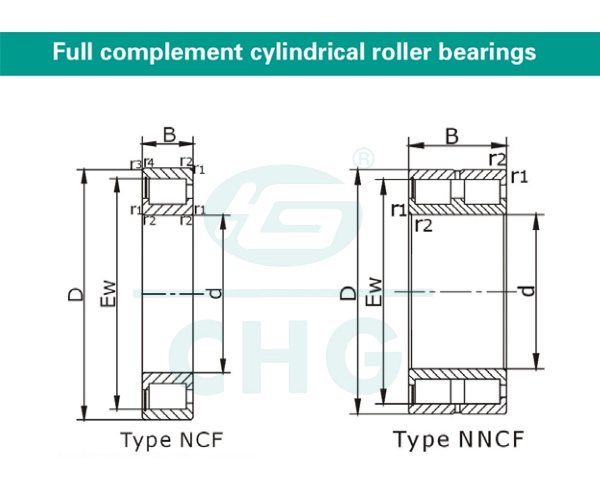What is the Load Capacity of Full Complement Cylindrical Roller Bearings?
Full complement cylindrical roller bearings are specialized rolling element bearings designed for substantial loads in industrial applications. Unlike conventional bearings with cages, these maximize roller count within the assembly, significantly enhancing load capacity. The absence of a cage allows more rollers in the same space, creating a solution that excels in heavy-duty environments. This article explores the load capacity characteristics of these bearings, examining their design, performance capabilities, and optimal applications.

How Does the Design of Full Complement Cylindrical Roller Bearings Affect Their Load Capacity?
The Impact of Roller Quantity on Load Distribution
The defining characteristic of full complement cylindrical roller bearings is their maximized number of rolling elements. Without cages, these bearings accommodate significantly more rollers within the same dimensions. This increased roller count directly enhances load distribution capabilities. When load is applied to a Full Complement Cylindrical Roller Bearing, force distributes across more contact points, reducing stress concentration on individual rollers. This design principle allows these bearings to handle substantially higher radial loads compared to conventional caged bearings of similar size. The scientific principle involves the relationship between contact area and pressure distribution—more rollers create more contact surfaces, reducing pressure per unit area and enabling greater overall load capacity without compromising structural integrity.
Material Selection and Its Influence on Load-Bearing Performance
Materials used in Full Complement Cylindrical Roller Bearings play a crucial role in determining load capacity. High-grade bearing steels, typically through-hardened or case-hardened chromium steels like 100Cr6 (AISI 52100), are standard due to their excellent wear resistance and fatigue strength. Advanced materials technology has enabled specialized steel compositions with enhanced purity levels and controlled microstructure, improving load-bearing performance. Premium bearings may feature specially treated surfaces enhancing durability under extreme load conditions. Surface treatments such as black oxide coatings or specialized heat treatments can increase resistance to wear and surface fatigue, maintaining load capacity over extended operational periods. Material selection is particularly important for applications involving shock loads or vibration.
Dimensional Precision and Its Effect on Load Capacity
Manufacturing precision directly affects the load capacity of these bearings. Dimensional accuracy and surface finish quality of rollers and raceways determine how effectively the bearing distributes loads across all rolling elements. Modern manufacturing ensures tight tolerances, often measured in micrometers, enabling optimal contact patterns between rollers and raceways, preventing uneven load distribution. When all rollers maintain consistent dimensions, they share applied load equally, allowing the bearing to approach its theoretical maximum load capacity. Manufacturing imperfections creating size variations can cause certain rollers to bear disproportionate loads, potentially reducing overall capacity and accelerating wear. Premium manufacturers implement rigorous quality control to ensure dimensional consistency across all components.

What Factors Determine the Maximum Load Rating of Full Complement Cylindrical Roller Bearings?
Static and Dynamic Load Ratings Explained
Full Complement Cylindrical Roller Bearings come with two distinct load rating specifications. The static load rating (C0) represents the maximum stationary load that can be applied without causing permanent deformation. The dynamic load rating (C) indicates the load under which the bearing achieves a rated life of one million revolutions. For these bearings, these ratings are substantially higher than caged counterparts due to the increased number of load-carrying elements. Engineers must consider both ratings when selecting bearings, as exceeding either limit can lead to premature failure. The relationship between applied load and bearing life follows a cubic relationship—doubling the load reduces life to approximately one-eighth of the original expectation.
Operating Speed Limitations and Their Relationship to Load Capacity
While these bearings excel in load-carrying capacity, they face speed limitations compared to caged designs. At higher speeds, adjacent rollers contact each other, generating friction and heat that can reduce effective load capacity. This speed-load relationship creates an important consideration—as speeds increase, the practical load capacity may need downrating to maintain acceptable operational parameters. Manufacturers often provide speed factors or adjustment calculations to determine appropriate load ratings based on specific operating speeds. For applications requiring both high speeds and loads, special versions with optimized roller profiles and enhanced lubrication may be recommended to mitigate inter-roller friction issues.
Environmental Factors Affecting Load Capacity in Real-World Applications
Theoretical load capacity can be significantly affected by environmental conditions. Temperature fluctuations represent one of the most impactful factors—elevated temperatures reduce lubricant viscosity and can alter dimensional characteristics through thermal expansion, diminishing effective load capacity. Contamination is another critical consideration, as particles entering the bearing can create stress concentration points that dramatically reduce load-carrying ability. In humid or corrosive environments, special consideration must be given to material selection and protective treatments. Vibration and shock loading also influence practical load capacity, as momentary force spikes can exceed the static load rating even when average applied load remains within specifications.

How Do Full Complement Cylindrical Roller Bearings Compare to Standard Bearings in Load Capacity?
Comparative Analysis of Load Capacity Between Bearing Types
Full Complement Cylindrical Roller Bearings demonstrate significant advantages over standard caged bearings of similar dimensions, typically offering 30-60% higher radial load capacities. This increase stems directly from the greater number of rolling elements. Where a standard bearing might contain 12-16 rollers, a full complement version could incorporate 20-24 rollers, dramatically increasing total contact surface area for load distribution. This advantage becomes pronounced in applications with severe space constraints. The tradeoff comes in increased friction and heat generation, particularly at higher speeds. For pure load-carrying capability, these bearings remain unmatched among similarly sized rolling element bearings.
Application-Specific Advantages in High-Load Scenarios
These bearings offer particular advantages in specific high-load applications. In industrial gearboxes, they excel at supporting massive radial loads while occupying minimal axial space, making them ideal for planetary gear systems. Mining equipment benefits from their ability to withstand both heavy continuous loads and shock loading conditions common in crushers and conveyors. Steel mill equipment, including continuous casting machines and rolling mills, leverages these bearings' ability to handle extreme loads associated with metal forming processes. Paper mills rely on them in press rolls and calendering equipment, while construction equipment manufacturers specify them for applications like crane slewing rings and hydraulic cylinder supports.
Cost-Benefit Analysis of Full Complement vs. Standard Bearings
When evaluating economic implications, several factors beyond initial purchase price must be considered. While full complement designs typically command a premium compared to standard bearings, their enhanced load capacity often translates to tangible benefits over the equipment lifecycle. Higher load ratings allow engineers to specify smaller bearing packages, potentially reducing overall system size, weight, and cost. Superior load handling can extend maintenance intervals, reducing downtime frequency and associated production losses. These benefits must be weighed against potentially higher maintenance requirements when service is needed. For static or slow-moving heavy load applications, these bearings often present the most cost-effective solution when evaluated across the entire operational lifespan.
Conclusion
Full complement cylindrical roller bearings offer superior load capacity compared to standard bearings due to their maximized roller count and optimized design. Their performance depends on proper material selection, precision manufacturing, and appropriate application within speed limitations. These bearings excel in heavy industrial environments where space constraints and high loads present significant challenges. When selecting these specialized components, engineers must consider both static and dynamic ratings while accounting for environmental factors that may impact performance. For applications prioritizing load-handling capabilities over high-speed operation, full complement designs represent an optimal bearing solution.

Luoyang Huigong Bearing Technology Co., Ltd. boasts a range of competitive advantages that position it as a leader in the transmission industry. Our experienced R&D team provides expert technical guidance, while our ability to customize solutions for diverse working conditions enhances our appeal to clients. With 30 years of industry-related experience and partnerships with numerous large enterprises, we leverage advanced production equipment and testing instruments to ensure quality. Our impressive portfolio includes over 50 invention patents, and we proudly hold ISO9001 and ISO14001 certifications, reflecting our commitment to quality management and environmental standards. Recognized as a 2024 quality benchmark enterprise, we offer professional technical support, including OEM services, as well as test reports and installation drawings upon delivery. Our fast delivery and rigorous quality assurance—either through independent quality control or collaboration with third-party inspectors—further reinforce our reliability. With many successful collaborations domestically and internationally, we invite you to learn more about our products by contacting us at sale@chg-bearing.com or calling our hotline at +86-0379-65793878.
References
1. Harris, T.A. & Kotzalas, M.N. (2022). Essential Concepts of Bearing Technology. CRC Press, Boca Raton.
2. Palmgren, A. (2021). Ball and Roller Bearing Engineering. SKF Industries, Philadelphia.
3. Johnson, K.L. (2023). Contact Mechanics and the Load Capacity of Rolling Element Bearings. Cambridge University Press, Cambridge.
4. Liu, J. & Wang, Y. (2022). "Comparative Analysis of Load Distribution in Full Complement versus Caged Cylindrical Roller Bearings." Journal of Tribology, 144(3), pp. 031701-031712.
5. Schmidt, R.H. & Bauer, P. (2024). "Environmental Factors Affecting the Performance of Industrial Bearings in Heavy Load Applications." Tribology International, 173, pp. 107-118.
6. Zhang, H., Wang, L., & Chen, Q. (2023). "Advancements in Material Technology for High Load Capacity Roller Bearings in Mining Applications." Wear, 502-503, pp. 204227-204236.

